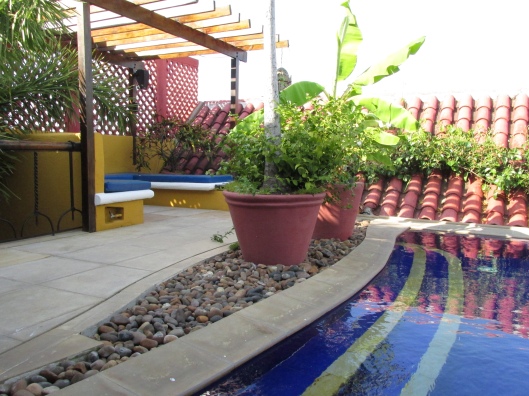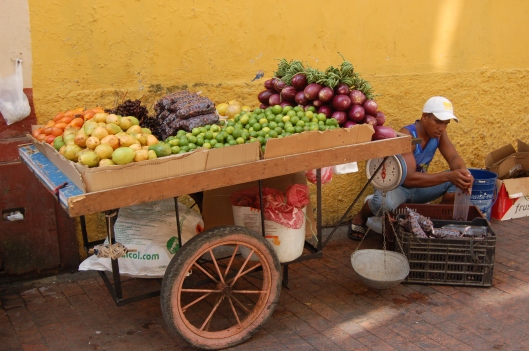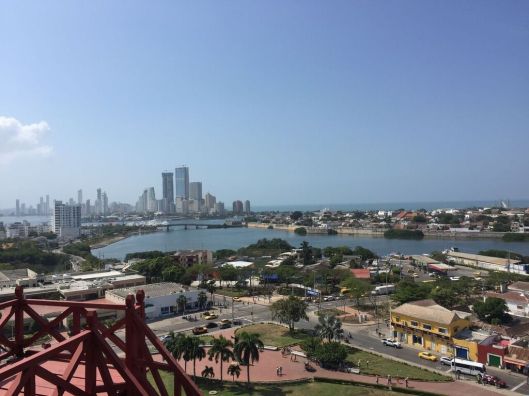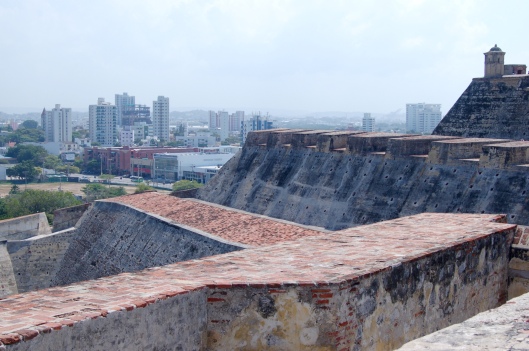A cross between New Orleans and the Caribbean, decreed my daughter. What I imagine Cuba would be like, noted my son. Streets and doors like San Miguel de Allende, opined my husband, but maybe more like San Juan. As for me, I was thinking sort of like Dubrovnik with Afro-Latino overtones.
These were our shallow observations in our first few hours in Cartagena, Colombia. I always find it kind of obnoxious when people (including us) blather on about what a place reminds them of, as if they (we) are so well traveled that they have to compare and contrast each new place with somewhere they’ve already been rather than just appreciating it for what it is itself. Yet we all found ourselves exclaiming time and again how Cartagena reminded us of so many other places, and perhaps this makes sense at first glance.
Cartagena de Indias was founded on the Amerindian north coast of what is now Colombia by Spanish conquistadors in the early 1500s. With its well-protected location on a Caribbean bay, Cartagena became a critical port for all the riches the Spanish were carting out of South America; ships from Peru and Ecuador stopped here to receive additional goods from Colombia, then continued on to Cuba and Puerto Rico before sailing to Spain with all their seized treasure. These ships full of gold and silver and the prosperous young city attracted a long string of pirate attacks, leading to the building of one of the largest fortifications and walled cities in the Americas.
Cartagena’s development was aided greatly by the dubious honor of becoming one of the busiest slave ports in Central and South America. The slave trade further enriched the Spanish conquerors, and stately mansions with deeply colorful stucco and stone walls, tall windows and doors, and flowery balconies sprang up in a series of cobblestone streets and small parks in the Old City.

Cartagena eventually became one of the first sanctuaries for freed African slaves, who lived alongside the indigenous residents and European conquerors, creating a delicious stew of ethnicities and cultures. Indians, Hispanics, and Africans mix here in a steamy Caribbean setting, and the buildings, food, music, and culture in general reflect centuries of cross pollination.
Today, dozens of indigenous ethnic groups remain, along with several million Afro-Colombians and some 30 million mestizo (European-Amerindian) inhabitants. Getsemaní, the city’s oldest area, where we stayed, was the original home of Africans brought as slaves and later the home of a large Cuban population. The colonial Old City looks more European, but is also home to a fusion of people, homes, and businesses.
In the end, we appreciated this walled city of cobblestone streets, artfully crumbling colonial architecture, and masses of trailing bougainvillea for its own charms. It is simultaneously seedy and enchanting, suffocating and breezy, old world and trendy.

Typical Caribbean foods – coconut milk, lime, rice, plantains, and fish – are served alongside Colombia’s signature dish, arepas – little cornmeal patties stuffed with cheese, eggs, and other fillings. Street corner cumbia music mixes with Latin salsas, and a gleaming row of high-rise hotels and condos lines the beachy Bocagrande strip, Miami style, within sight of the 16th century Castillo de San Felipe de Barajas, a dominating fortress built by the Spanish.
Is it any wonder we all likened the city to so many different kinds of places? Cartagena does look and feel like other Latin American colonial cities like San Miguel de Allende and San Juan, and it has the balconies, decadence, and Afro-European fusion of New Orleans. Its Cuban population adds both Latino and island flavor, and the city walls certainly evoke other fortified cities like Dubrovnik. By the end of our time there, however, we concluded that all the comparisons were unnecessary and unfair; Cartagena is a unique little place of its own and well worth a visit.













Gorgeous pics and great story! Didn’t realize Cartagena was such a fusion. Definitely an interesting destination to think of!
LikeLiked by 1 person
I didn’t quite realize that either. And we had started in Bogota, so I expected more of the same, but it was like a different country in some ways. Both were awesome!
LikeLiked by 1 person
I had to check the map after reading your post and it surprised me to see that Cartagena is actually really close to Aruba, which I’ve been to. Would you say Colombia was safe for a tourist right now, all in all?
LikeLiked by 1 person
We felt 100% safe in both Bogota and Cartagena. In fact, we wandered Bogota using googlemaps and never once strayed into any neighborhood we felt uncomfortable in. We walked home at night (in our group of 5, which does help) from all over the city. Cartagena was the same – in the Old City, Getsemani, and I’m sure Bocagrande, there are no big worries – pickpockets probably (like anywhere touristy) but nothing related to the old days of drug-related kidnappings, killings, etc. We were told the only areas in the country to avoid were remote parts of the countryside, where the guerrillas still exist to some extent.
LikeLiked by 1 person
Cartagena first evoked my curiosity when I was still a kid, back in the time when Colombia was still rife with bloody conflict. As the country became a much safer place in recent years, Cartagena reemerged in my mind. I guess it’s natural for us to compare a new place we visit to those we have been. Only after we delve deeper into the culture and daily life and explore the place further that we’ll see the uniqueness of that place.
LikeLiked by 1 person
That’s so interesting that you were intrigued by Cartagena as a kid. I think I thought of it in the context of pirates, which piqued my curiosity also, but it wasn’t until I was an adult, eager to see lots of South America, that it reentered my imagination. And you’re right about comparisons; I just get mad at myself for always looking to compare right away instead of looking for uniqueness right off the bat!
LikeLike
I was near Cartegena for ten days about 35 years ago and didn’t go into the town – too busy lazing in that beautiful Caribbean water all day. Now I wish I’d gone – it looks very enticing. And that first photo definitely reminds me of San Miguel where we are right now.
Alison
LikeLiked by 1 person
It was indeed quite enticing! But I think you’ve got enticing and more there in San Miguel! How are things so far? … are you settling in? … do you feel relaxed and more able to keep up with things, like blogs?! (Sorry – I’m often accused of asking too many questions at once, but I’m vicariously excited that you’ve got such a nice extended stay there.)
LikeLiked by 1 person
It has taken a week, but we have finally settled in. It was not an easy week but the worst is over – it will be the subject of the next post. Definitely starting to feel more relaxed and able to keep up with blogging. Two days ago I was up by 5am because I had ideas for four posts running through my head! Two and a half of them done already. Feeling inspired!
Alison
LikeLiked by 1 person
It seems like a place that bombards the senses…in a good way. I love your self-deprecating sense of humor. We humans have a need to put everything into tidy little categories, don’t we?
LikeLiked by 1 person
I never thought of it that way, but yes! And I am so guilty sometimes … even though I should know better by now. What really bombarded us was the temperature; it was about 95 every day, and the humidity was outrageous. That, on top of the sights, smells, and sounds did make for a sensory assault … in a good way!
LikeLike
Dubrovnik with a Afro-Latino overtone! Lol. I loved that line! Colombia is high on my list. Actually, the vague plan is that when baby girl gets a bit older, we will go visit the relatives in Peru. While husband visits family in Lima, I scoot outta there and take a flight to Colombia! Lol. You can tell I’m not too keen on the in laws huh? 😉
LikeLiked by 1 person
That cracked me up! One always needs an escape form the in-laws! Colombia would be a good one, especially if you could get to both Bogota and the coast. They are so different and showcase two different sides of Colombia. Bogota is a classic Andean bowl city/capital, but Cartagena has that laid-back coastal vibe. Hope you get to go!
LikeLike
The in laws aren’t so bad…. It’s just hard when you don’t know the language, there is a huge family and you are stuck in a tiny apartment in a polluted city of 11 million. I dont really want to be stuck in Lima for 3 weeks (I go crazy after 3 days lol). Even hubby agrees it’s best to send me elsewhere while he stays behind visiting everyone. Win for me! Lol
LikeLiked by 1 person
I never really considered Columbia for a bucket list destination, but the images from your last couple of posts has me wondering. Nice.
LikeLiked by 1 person
That makes me happy! I’ve found a few new places to add to my list on others’ blogs also. In a way, reading blog posts and viewing photos from “regular” people seems like a better method of finding new places than professional travel companies, magazines, etc. Individuals have no vested interest, and I like to think they/we tell it like it is versus trying to sell a place. So many people have commented that they were afraid Colombia was unsafe; I hope hearing that we had zero problems there makes people more comfortable with the idea of visiting!
LikeLike
Beautiful! I would love to go to Colombia Lexi! It looks amazing!
LikeLiked by 1 person
And I’d like to go to Bolivia, one of the subjects of your post today! South America offers so much, and isn’t it great to travel into the same time zone (or close)! I am getting spoiled.
LikeLiked by 1 person
I love traveling in the same time zone. 🙂 Where is next for you?
LikeLiked by 1 person
Just arrived (solo) in Nicaragua a few hours ago! Hiking a volcano tomorrow, kayaking, hiking, and touring in general for the rest of the week! Stay tuned …
LikeLiked by 1 person
Wow and you just got back from Colombia! How fantastic!!! Keep me posted! I land in Managua and need a hotel recommendation if you have one!
LikeLiked by 1 person
Will send you a message when I get back!
LikeLiked by 1 person
I love the mural at the end. It reminds me of… oh, heck. I don’t know. I just really like it.
LikeLiked by 1 person
Haha, very funny! We all posed in front of that for our Happy New Year card (I was too lazy to get one done by Christmas time).
LikeLiked by 1 person
Cartagena is one of those places I’ve always wanted to go to and not got around to it. I have, however, been to Dubrovnik and I was trying to imagine Afro-Latino overtones. I think I clicked when I saw your fortification pictures.
LikeLiked by 1 person
Well, now is a good time to go! It’s feeling very safe there, and your money goes a lonnnngggg way! I think my Dubrovnik reminders were mostly the walls and the narrow streets within. It is really a different vibe overall, though.
LikeLike
Your posts are always so inspiring, we can tell how much you appreciate the places you are featuring. Thanks for introducing Cartagena, I really enjoyed the ride, especially how you described the multicultural influences ..
I bet they have great fusion food there too..
LikeLiked by 1 person
Thanks! – I have not yet met a place I didn’t like at least a little bit! And the food was amazing – coastal/Latino/continental/yum! And the best part – super inexpensive! We would roam the walls before dinner and drink $1 beers, then feed a family of 5 for less than a nice meal in Chicago for 2 people!
LikeLiked by 1 person
OK sold! on my bucket list!
LikeLiked by 1 person
Boy am I jealous now after seeing these photos. This is not what I had pictured in my mind about the place. In my mind, there were lots of dark alleys, stone buildings with bad guys lurking and waiting to slit your throat—I have seen all those movies, you know. And the movie, Romancing the Stone didn’t make the city look so cool. Now, it’s on my list of places to see.
LikeLiked by 1 person
You’ve got the old/movie view! Alleys, yes, but not dark and creepy. Stone buildings galore, but no bad guys lurking with knives! Really quite charming overall, so change up your continent next vacation and get yourself to South America!
LikeLike
OK, done: Cartegena…now on my list of places to see. I do love that they speak Spanish there. I can get by barely
LikeLiked by 1 person
I can see why it makes you think about Dubrovnik. But I can also see a bit of New Orleans in it haha ! And yes, you are so right, we all do that, we always try to compare. Personally I don’t think it’s a bad thing because it goes away very quickly.
I really love the colours, it really has a Latino feeling (oops I did it again)
LikeLiked by 1 person
Impossible not to draw some comparisons! The colors were incredible; every building was a new pastel hue, and the flowers and fruits and clothing just added to the color!
LikeLiked by 1 person
Quite a lovely portrayal of a beautiful place. Have never been but you made it look really appealing Lex – comparisons notwithstanding! Love that last shot.
LikeLiked by 1 person
Thanks! Our family took a photo in front of that great “Me gusta Colombia” wall painting and used it for a New Year’s card. Perfect message after our trip!
LikeLike
Colombia has been slowly rising to the top of my travel wish list. But it’s been branded as “dangerous” for so long. Great to see it through your eyes and know that this isn’t an accurate portrayal.
LikeLiked by 1 person
Yeah, Colombia kind of percolated up for me over the last few years also. We found it almost shockingly safe-feeling. We walked all over Bogota (and certainly Cartagena) and never felt anxious at all. Very cool country – go!
LikeLiked by 1 person
I never visited and didn’t imagine it to look like that. Thanks. Very interesting. I like your observation about comparing places, and think is the main reason why sometimes people create stereotypes about places, not opening their minds to ‘see’ and learn about the city and its culture. And one wonders why they travel if all they want to see is what they have at home. I don’t mean this about your family, btw. Excellent point you made. Thanks.
LikeLiked by 1 person
It was different than I’d imagined also! Colombia is a fascinating and varied place, with Caribbean culture and lifestyles on the coast, the classic Andean bowl city feel in Bogota, and then there are mountains and jungles and forest and coffee plantations and all sorts of things in the rest of the country that we didn’t even have time to see!
LikeLike
I’ve visited only Bogota. Your description is fascinating and makes me want to visit.
LikeLiked by 1 person
Pingback: Out with the Old, In with the New! | One Foot Out the Door
Wonderful photos! I will be traveling there this month. Any recommendations?
LikeLiked by 1 person
Thanks! The old walled part of the city is the most atmospheric, although the throngs of tourists may get to you after a while. At that point, head over to Getsemaní, check out Cafe Havana and the nearby streets that are reminiscent of Cuba. The castillo is a fun outing, even if just for a view back toward the old town. Be sure to buy some $1 beers and stroll around the wall around sunset time! Have fun!
LikeLiked by 1 person
Thank you! Will do!
LikeLiked by 1 person
Me gusta Colmbia tambien!
I enjoyed reading your post and looking at your beautiful photographs. Cartagena looks like somewhere that I would love, with all of my favourite elements. I haven’t been to Colombia in a couple of years but if I’m lucky enough to go again I will add a weekend in Cartagena.
LikeLiked by 1 person
I meant to type Colombia not Colmbia! I injured my right ring finger playing netball last night and it missed the o althogether!
LikeLiked by 1 person
Where have you been in Colombia? We had a great time everywhere we went!
LikeLike
You captured Cartagena perfectly. Lovely post!
LikeLiked by 1 person
Thank you! Gosh, seems like lightyears away now! Can’t wait to get out and visit the world again.
LikeLiked by 1 person